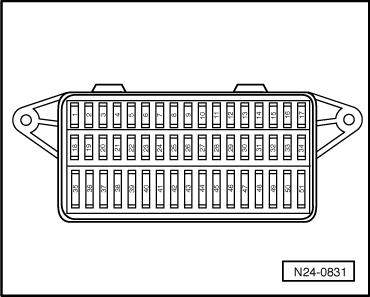Polo Mk3
 |
|
Functional check
Lambda probe dynamics diagnosis |
| → Indicated on display: |
|
||
|
| → Indicated on display: |
|
||
|
|
→
Indicated on display: (1...4 = Display zones) |
|
||
Note: This process can take a few minutes.
If the display does not indicate as described:
=> Repair group 01; Fault memory; Interrogating and erasing fault memory of engine control unit If the display indicates as described:
Catalyst diagnosis Note: The diagnosis will only be terminated if the Lambda probe dynamics diagnosis is first successfully completed. |
| → Indicated on display: |
|
||
|
|
→
Indicated on display: (1...4 = Display zones) |
|
||
If the display does not indicate as described:
=> Repair group 01; Fault memory; Interrogating and erasing fault memory of engine control unit If the display indicates as described:
|
